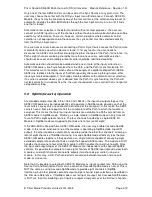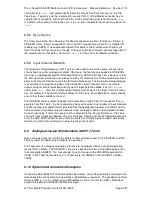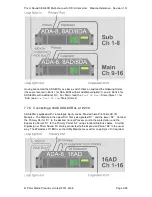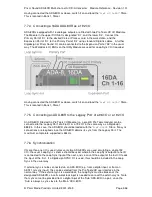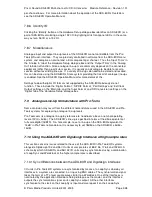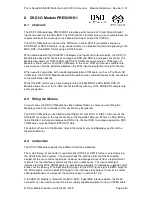
Prism Sound ADA-8XR Multi-channel A/D D/A Converter Module Reference - Revision 1.01
© Prism Media Products Limited, 2001-2005
Page 3.25
6.7 Synchronization
Pro Tools 24|MIX workstations synchronize data transfer to and from their interfaces by taking
a clock from one of them and distributing it to all the others via the Pro Tools data cables. The
interface providing the clock to the workstation is the ‘first in the chain’ (if more than one
interface is used), that is, the interface connected to the first card in the workstation, or to the
‘A’ leg of the ‘Y cable’ on that card, if a Y cable is used. This interface is referred to herein as
the ‘Master’ interface, or the Master converter.
So considering a number of ADA-8XRs connected to Pro Tools 24|MIX: the Master ADA-8XR
has its record Path (usually Path 1) independently synchronized - either using its own crystal
or an external source (e.g. Wordclock, AES11, or a digital input). Its playback Path (normally
Path 2) and all the other Paths of all the other ADA-8XRs should be synchronized to the clock
distributed on the Pro Tools data cable (DI1, if the Pro Tools I/O Module is located in DIO1).
This arrangement ensures that the whole system is synchronized from a single source and
that changes to the sample rate of that source will be reflected in all the ADA-8XRs. Note that
ADA-8XRs connected to Pro Tools must run their two Paths synchronously, at the same
sample rate.
It is possible to have a system where the Master interface does not have a record path, for
example where the Master ADA-8XR has only D/A Paths. In this case, the Path connected to
the first Pro Tools card (again, usually Path 1) should be independently synchronized while all
the other Paths should be synchronized to their respective DI (the Pro Tools I/O Module).
Like the 888|24, the ADA-8XR is capable of providing digital as well as analogue inputs to a
workstation, provided an appropriate digital I/O module is fitted (e.g. AES3). For correct
operation, any digital inputs must be synchronous with the rest of the system. To achieve this,
either the source of the digital inputs must be synchronized to the Master interface (or to its
sync source) or the Master interface must be synchronized to its digital inputs (normally DI2).
ADA-8XRs may be used in Pro Tools 24|MIX systems alongside 888|24s, although the
888|24’s synchronization requirements are somewhat more restrictive. The ADA-8XR can
extract all the information needed to synchronize and run its converters from the Pro Tools
data cable. The 888|24 however, requires an extra, high-speed clock to run its converters that
it cannot synthesize from the data cable, which is known as Superclock (SCK).
The ADA-8XRs do not need to work from a Superclock input, because their internal PLLs
(phase-locked loops) synthesize all the necessary high-speed clocks for the converter
devices locally. 888|24s need Superclock because they don’t have the necessary PLLs to
derive conversion clocks from lower-rate reference clocks such as Wordclocks. However, it is
the PLLs in the ADA-8XR which also reject incoming clock jitter to create a distortion-free
conversion. The practice of distributing conversion clocks between equipment without local
jitter filtering may create distortion levels unacceptable for high-quality applications.
All the 888|24s in a system must be fed SCK from the Master interface, regardless of whether
that is an ADA-8XR or another 888|24. The SCK output from the Master interface is
connected to the Supeclock input of the first 888|24, whose output is fed to the input of the
next, and so on. An 888|24 has SCK output permanently available on a connector on its rear
panel, whereas an ADA-8XR generates SCK from the Wordclock output on its rear panel
when the appropriate option is set in the Wordclock Sync Output menu (see the Firmware
Reference).
If all this sounds a little complicated, don’t worry! The Factory Default Stores which are
automatically available in ADA-8XRs fitted with Pro Tools I/O Modules make it a simple job to
set up, simply by loading the appropriate Store, as detailed in section 6.6. The correct Store
to choose for each ADA-8XR in the system depends only on whether it is to be the Master
interface and, if so, whether or not it is to be locally or externally synchronized. This will
usually be local, unless a USD (Digidesign ‘Universal Slave Driver’) is in use in which case it
will be external, from the USD’s Wordclock output. The three Store options are described
below. Note that for ADA-8XRs configured for 16-channel A/D or 16-channel D/A (or some









